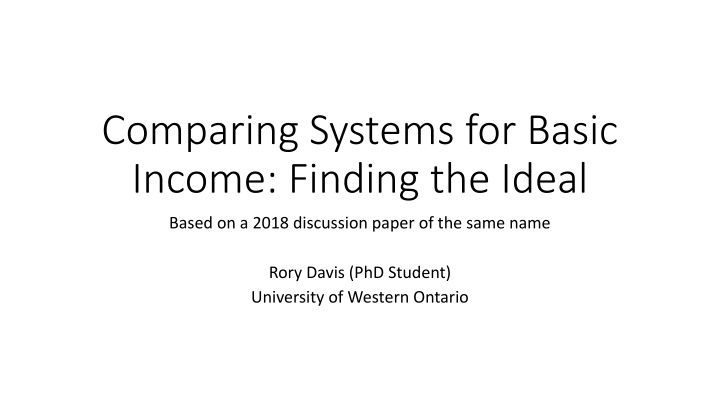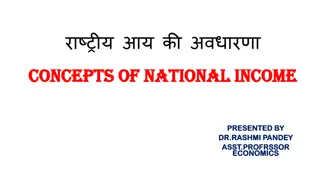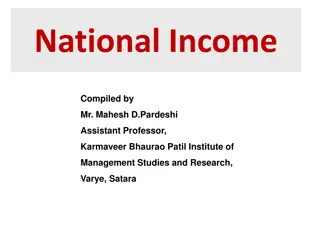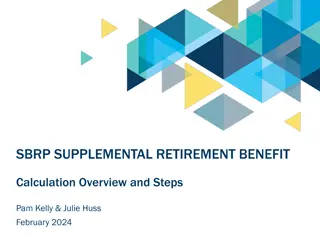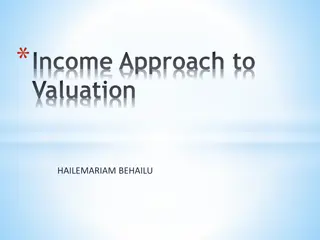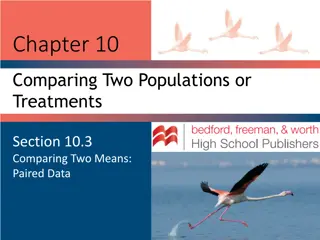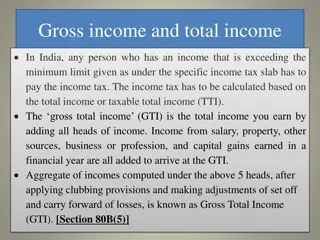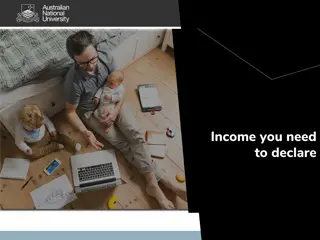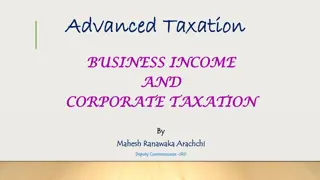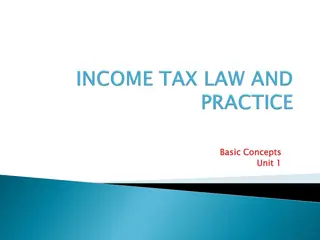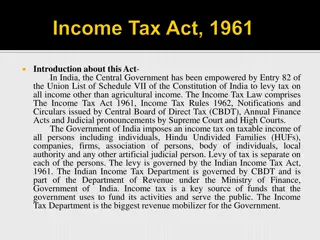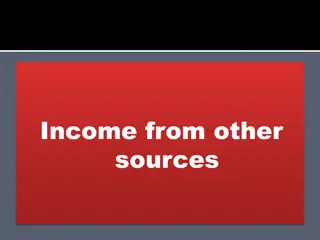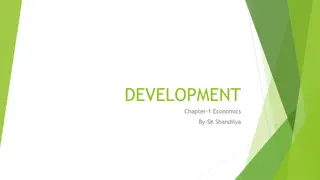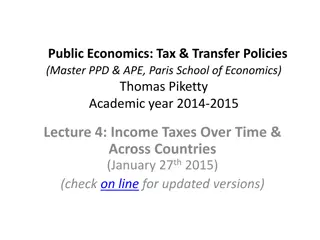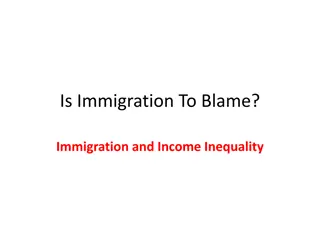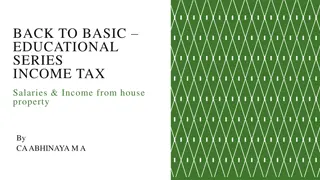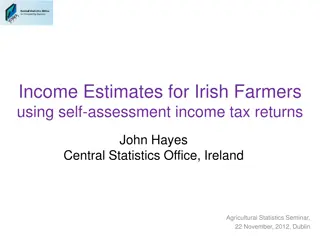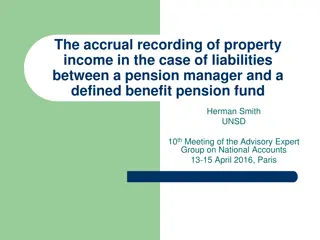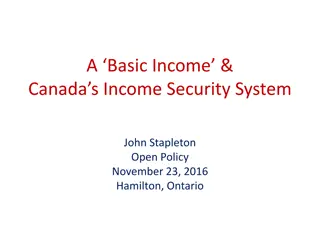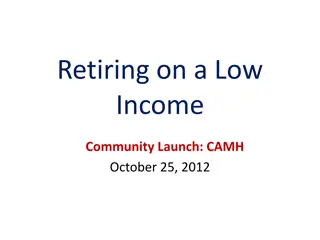Comparing Systems for Basic Income: Ideal Concepts
This presentation discusses various systems for basic income, analyzing criteria such as freedom, justice, sustainability, and achievability. It explores the Negative Income Tax (NIT), Job Rents, Resource/Land Value Tax (Alaska), and Ontario Works/Ontario Disability Support Program to evaluate their effectiveness in providing financial aid and achieving social security goals.
Download Presentation

Please find below an Image/Link to download the presentation.
The content on the website is provided AS IS for your information and personal use only. It may not be sold, licensed, or shared on other websites without obtaining consent from the author.If you encounter any issues during the download, it is possible that the publisher has removed the file from their server.
You are allowed to download the files provided on this website for personal or commercial use, subject to the condition that they are used lawfully. All files are the property of their respective owners.
The content on the website is provided AS IS for your information and personal use only. It may not be sold, licensed, or shared on other websites without obtaining consent from the author.
E N D
Presentation Transcript
Comparing Systems for Basic Income: Finding the Ideal Based on a 2018 discussion paper of the same name Rory Davis (PhD Student) University of Western Ontario
Structure of Comparison Systems for Basic Income Comparison Criteria Negative Income Tax (NIT) Job Rents Resource/Land Value Tax (Alaska) Justice Freedom Sustainability Achievability Reference point Ontario Works and Ontario Disability Support Program (ODSP)
Analysis Criteria Freedom Is about how much money is being provided Is about what opportunities that the new financial aid presents Is about freedom from the many pitfalls of weak social security, including: The welfare trap (welfare wall) Stigmatization Watchdog mentality and policing the poor Is about gaining a mentality of security and shedding the mentality of scarcity Justice Is about where the money is coming from Does it operate alongside or replace other social programs? Is new taxation considered? Is redistributive justice a goal? Is about who has access: Is the program about universality or limited access? What is the inclusion/exclusion criteria?
Analysis Criteria Sustainability Is about protecting the program from erosion Decreasing benefits Limiting accessibility Weak social security Is about preserving the incentive to work Economies support benefit systems Is about maintaining functionality, political support, and cultural legitimacy Achievability Is about getting the program implemented/making basic income a reality It is sensitive to the current political climate It is skeptical of plans that involve a lot of change (especially all at once)
Program Analysis Applying the 4 criteria to Evaluate: Negative Income Tax (NIT), Job Rents, Land/Resource grants (Alaska), and Ontario Works/Ontario Disability Support Program
Negative Income Tax (Ontario) Freedom More money is granted than Ontario Works/ODSP 45% LIM vs. 75% LIM Greater opportunities in life decisions affected by income Changes to administrative apparatus are aimed to tear down the welfare wall Mixed gains for combatting stigmatization of those in poverty Benefits still only accessed by the poor But watchdog/policing reduced Justice Wealth redistribution is not a priority Limited access: only those below break even point benefit leaves the door open to reintroduce workfare principles Ex. Socially productive labour requirement Aims to scrap administrative apparatuses to save money transfer those savings to welfare recipients i.e. raise funding from the bottom instead of the top
Negative Income Tax (Ontario) Sustainability The program does improve the work incentive relative to Ontario Works Claw backs and punishments for prudent behaviour (working, saving) are removed But, a key population of stakeholders are removed: welfare workers Due to downsizing administration to save on admin costs Achievability A lot of momentum exists for the NIT system of basic income Test sites include: Finland, Scotland, Netherlands, Uganda, and Ontario Could be some danger in Ontario of pilot being abandoned if a government change happens June 7, 2018 Same fate as Mincome (1970s) NDP initiated 1974 PC cancelled 1979
Job Rents Freedom All opportunities from NIT + softening of the need to preserve the work incentive Can opt out of employment Absence of job envy Product of rent system Changes are aimed to eliminate bad jobs Have no one work an undesirable job for insufficient compensation Justice Is not about wealth redistribution Hierarchy of earning is maintained But, the top earners are anchored to the lowest earners since the more envy their position inspires the higher the rent to hold onto that job Counter force to opportunity hoarding It becomes less financially rewarding to restrict access to the best jobs due to scarcity driving the rent price up Universal Access Everyone must participate
Job Rents Sustainability If fully implemented and enforced (prevent rent dodging) then the system is protected and self- perpetuating Applying job rents totally interweaves social security (welfare provision) with employment It is insulated from spending cuts by governments The system would be affected by economic downturns, depressions, recessions, and capital flight Achievability Job rents are the most theoretical and most utopian of the basic income systems A lot of revamping of existing institutions would have to take place As well as a cultural shift away from the work to eat principle that is embedded in our understandings The system runs counter to corporate interest and corporations have a significant sway over politics
Land or Resource Tax (Alaska s Permanent Fund Dividend) Freedom Fairly modest, but significant dividend (affected by value of a resource; ex. Oil) Moderate purchasing power increase No work requirement; only citizenship requirements For Alaska, this means present in the state for a minimum 180 days Also, incarceration would devoid payment Also, illegal immigrant status means no payment Justice Is progressive in its transparency (no government misallocation of funds) and requirement of business social responsibility (taxation on resource extraction) It also operates alongside other social service programs It is not a welfare replacement, it is a supplementary income It may be somewhat contentious in how citizenship requirements are fulfilled as various court challenges illustrate
Land or Resource Tax (Alaska s Permanent Fund Dividend) Sustainability It could be a weakness that the dividend relies on the existence of finite resources and industries committed to extracting them (and paying taxes) In terms of popular support, the program in Alaska is enshrined in the consciousness of citizens They conscientiously defend it Achievability As a program that has functioned for over 30 years in Alaska the citizen s dividend has proven achievable in a specific location However, not all territories have a rich natural bounty to justify the dividend through resource taxation If approached as a land tax instead, achievability might decrease but sustainability would increase
Ontario Works Freedom The thrust of the program is to prevent parasitism Assumes welfare recipients are second class citizens who need a paternalistic push back to work Heavy emphasis on stigmatizing the recipients of welfare as lazy or frauds Prudent behaviour like saving or working is punished by clawbacks of welfare aid The welfare wall or welfare trap Exacerbated by precarious employment Justice The claim to justice is the alleviation of taxpayer burden However, the funds cut from social welfare do not necessarily equate to benefits for the average citizen (Contingent on where the government reallocates funds) Weakening the social safety net can be considered an injustice based on the criteria of this study The program is not about reducing poverty The program is about restricting access and creating obstacles to receiving aid
Ontario Works Sustainability In terms of program cost Ontario Works could be said to work as a sustainable model Economically (in spending terms) Affordability is given priority over functionality The weakness of Ontario Works as a social security system might actually result in less survivability for the program itself It enables more functional systems (basic income) room for greater appeal BUT, Ontario Works has been in place with little change since 1997 (21 years) Achievability This system is easily justified on purely economic terms So long as the costly impacts (impaired health, crime, etc.) are not considered It was achieved by harnessing cultural bias (stigmatizations) against those in poverty and promising tax cuts Anecdotes about welfare cheats, drug use, laziness Biasing the population against welfare claimants is necessary to legitimize political rhetoric for spending cuts Us vs. Them mentality
Interpretative Ranking Freedom 1 Job Rents 2 Negative Income Tax 3 Land/Resource Tax 4 Ontario Works Justice 1 Job Rents 2 Land/Resource Tax 3 Negative Income Tax 4 Ontario Works Sustainability 2 Negative Income Tax 2 Job Rents 3 Ontario Works 4 Land/Resource Tax Achievability 1 Ontario Works 2 Land/Resource Tax 2 Negative Income Tax 4 Job Rents
Relative System Strengths/Weaknesses 4 = Most, 1 = Least 4 3 2 1 0 Negative Income Tax Job Rents Land/Resource Dividend Ontario Works Freedom Justice Sustinability Achievability
Conclusions The point of this discussion paper was not really to crown a champion basic income program. The point was moreso to make suggestions that can integrate into an achievable basic income system. These suggestions would be aimed to improve a program by focusing on freedom, justice, and sustainability Based on the criteria used, and the analysis conducted, the Negative Income Tax system does seem to be the best step forward for basic income in Ontario at this time.
Recommendations There are some changes that could be made that would make it even better: Using a universal demogrant instead of the strict Milton Friedman model is more effective vs. stigma (greater freedom) Being more proactive about a progressive tax on the wealthy would achieve greater justice This probably cannot be taken to the point of job rents or a de facto maximum wage , but even small steps in this direction are commendable It is problematic to overemphasize administrative cost savings the elimination of certain stakeholders (welfare agents) is a blow against sustainability Increasing the income tax/corporate tax burden on the wealthy is one alternative, but a balance must be struck to avoid capital flight and overly damaging outcomes for Ontario s economy One route is to learn from Alaska s program and incorporate natural resource and land tax (dividends) to operate alongside the new income tax system Negative Income Tax already has a good amount of momentum behind it; and this achievability is what makes it the ideal system to build upon
References Bakan, Joel. 2004. The Corporation: The pathological pursuit of profit and power. Free Press. Claeys, G., & MyiLibrary. (1989). Thomas Paine: Social and political thought. Boston: Unwin Hyman. Committee Documents: Standing Committee on Social Development - 1997-Sep-29 - Bill 142, Social Assistance Reform Act, 1997. Online: http://www.ontla.on.ca/web/committee- proceedings/committee_transcripts_details.do?locale=en&Date=1997-09-29&ParlCommID=54&DocumentID=19039 Danziger, S., Corcoran, M., Dansiger, S., Heflin, C., Kalil, A., Levine, J., Rosen, D., Seefeldt, K., Siefert, K., & Tolman, R. (2002). Barriers to the employment of welfare Recipients. Available Online: http://www.psc.isr.umich.edu/pubs/pdf/rr02-508.pdf Donselaar, G. van. (2009). The right to exploit: parasitism, scarcity, basic income. New York: Oxford University Press Esping-Andersen, G. (1990). The three worlds of welfare capitalism. Princeton, NJ: Princeton University Press. Friedman, M. (1968). The Case for a Negative Income Tax: A View from the Right. In Basic Income: An Anthology of Contemporary Research. (ED) Widerquist, K., Noguera, J.A., Vanderborght, Y. and Wispelaere, J.D. (2013) Fromm, E. (1966). The Psychological Aspects of the Guaranteed Income. In Basic Income: An Anthology of Contemporary Research. (ED) Widerquist, K., Noguera, J.A., Vanderborght, Y. and Wispelaere, J.D. (2013) Griffin, C. L., Jr. (2012). The Alaska permanent fund dividend and membership in the state's political community. Alaska Law Review, 29(1), 79 Harris, M. (1994). The Common Sense Revolution. Available Online: https://www.scribd.com/doc/57099326/Common-Sense-Revolution. P1-24 Herd, D., Mitchell, A., and Lightman, E. (2005). Ritual of Degration: Administration as Policy in the Ontario Works Programme. Social Policy & Administration. Vol. 39(1), p 65-79 Lightman, E., Mitchell, A., & Herd, D. (2005). One year on: Tracking the experiences of current and former welfare recipients in Toronto. Journal of Poverty, 9(4), 5-25 Lightman, E., Herd, D., & Mitchell, A. (2008). Precarious lives: Work, health and hunger among current and former welfare recipients in Toronto. Journal of Policy Practice, 7(4), 242-259 Lightman, E., Mitchell, A., & Herd, D. (2010). Cycling off and on welfare in Canada. .Journal of Social Policy, 39(4), 523-542 Maki, K. (2011). Neoliberal Deviants and Surveillance: Welfare Recipients under the watchful eye of Ontario Works. Surveillance & Society. Vol. 9(1/2), p 47-63 Marangos, J. (2008). Thomas Paine (1737-1809) and Thomas Spence (1750-1814) on land ownership, land taxes and the provision of citizens' dividend. International Journal of Social Economics, 35(5), 313-325 Matthews, D. D., & Ontario. Ministry of Community & Social Services. (2004). Review of employment assistance programs in Ontario works and Ontario disability support program: Report. Toronto: Ministry of Community & Social Services. Parijs, P.v. (1995). Real freedom for all: What (if anything) can justify capitalism? Oxford; New York: Clarendon Press Pasma, Chandra, and Jim Mulvale (no date) Income Security for All Canadians: Understanding Guaranteed Income, BIEN Canada at: http://www.cpj.ca/files/docs/Income_Security_for_All_Canadians.pdf Pasma, C. (2010). Working through the work disincentive. Basic Income Studies, 5(2) Segal, H. (2016). Finding a Better Way: A Basic Income Pilot Project for Ontario. Available Online: https://www.ontario.ca/page/finding-better-way-basic-income-pilot-project-ontario Tobin, J., Pechman, J. A., & Mieszkowski, P. M. (1967).Is a negative income tax practical?. Indianapolis: Bobbs-Merrill. Vaillancourt, J. (2010). Ontario works - works for whom?: An investigation of workfare in Ontario. Black Point, N.S: Fernwood Pub.
